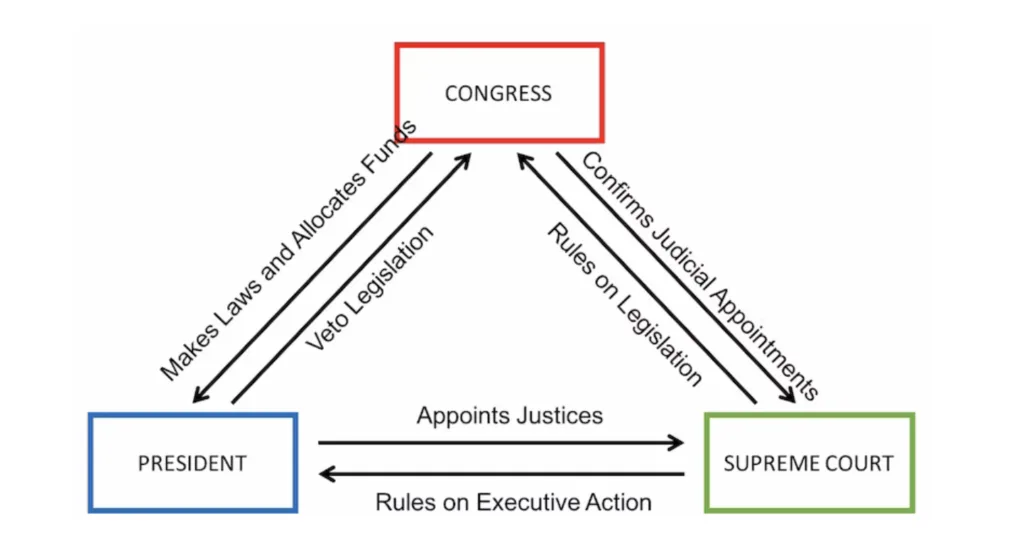The term “checks and balances” refers to the separation of powers that results from divided branches of government outlined in the U.S. Constitution.
The U.S. divides power among the three branches of government — executive, legislative, and judicial — to prevent any one from having too much power.
Each branch is said to have the ability to check the power of the others, thereby maintaining a balance in the government.
Though it’s sometimes said the United States has three “equal” branches of government, in reality the power of each has fluctuated throughout history.

Examples of “Checks and Balances”
Here’s how checks and balances work in the U.S. government:
- The president (Executive) is commander in chief of the military, but Congress (Legislative) approves military funds.
- The president (Executive) nominates federal officials, but the Senate (Legislative) confirms those nominations.
- Both the House and the Senate have to pass a bill in the same form for it to become law.
- Once Congress (Legislative) passes a bill, the president (Executive) has the power to veto it but Congress can also override the veto with a supermajority vote.
- The Supreme Court (Judicial) and other federal courts can declare laws (Legislative) or presidential actions (Executive) unconstitutional.
- The Senate (Legislative) confirms the president’s (Executive) nominations for judicial (Judicial) appointments.
- The House (Legislative) can impeach the President (Executive) or judges (Judicial). If the Senate (Legislative) finds the person guilty, they are removed from office.
The idea of separation of powers and checks and balances in government dates back to ancient times. The Greek statesman Polybius identified it as a “mixed” regime with three branches: monarchy… aristocracy…and democracy.
These concepts influenced later ideas about a separation of powers being crucial to self-government.
Historical context
Years later, in his work The Spirit of the Laws in the 18th century, author Montesquieu codified the idea of “checks and balances” when he warned of the threat of despotism by suggesting that there should be different parts of the government to exercise legislative, executive and judicial authority, all under the rule of law.
Montesquieu’s suggestion was later adapted by James Madison who wrote in the Federalist Papers:
The accumulation of all powers, legislative, executive, and judiciary, in the same hands, whether of one, a few, or many, and whether hereditary, self-appointed, or elective, may justly be pronounced the very definition of tyranny…
If men were angels, no government would be necessary. In framing a government which is to be administered by men over men, the great difficulty is this: You must first enable the government to control the governed; and in the next place, oblige it to control itself.
Most historians agree that, like with any part of living history, the system of checks and balances has served our country well but goes through periods of stress, particularly during events like government shutdowns.
As noted by The Hill:
Our forefathers in their wisdom established a system of checks and balances in our Constitution to limit power in any one branch of government. That system has worked effectively for more than 200 years to limit power, but it also led to periods of legislative gridlock. We are in one of those periods of total gridlock with the current partial shutdown of the federal government. Each of the parties has dug in.
Weaknesses
Throughout the years, many have argued the checks and balances system is failing.
During President Donald Trump’s administration, the system of “checks and balances” came under intense scrutiny, with a litany of articles suggesting the 45th president, with help from Congress, had placed too much power in the hands of the Executive branch.
The Atlantic noted:
By the letter of the Constitution, and by the unwritten norms of American separation-of-powers governance, the main restraint on an overreaching, dishonest, or incompetent executive is a resolute legislative branch. But today’s legislative leaders—Mitch McConnell and his slim Republican majority in the Senate, Paul Ryan and his large Republican majority in the House—are ostentatiously refusing to play that check-and-balance function.
Many attribute the rise of intense partisanship in the early 21st century to further erosion of the U.S. system of checks and balances.
Use of “Checks and Balances” in a sentence
- Checks and balances are a cornerstone of our free society, and they are mentioned often in our founding documents.
- The system of checks and balances is intended to prevent abuse of power and to ensure that the government remains accountable to the people.
- The candidate said she’s changed her mind on more checks and balances regarding elections being codified.